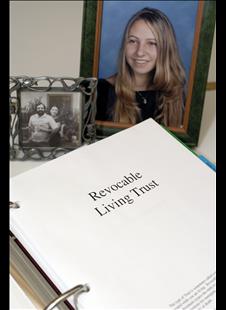|
|
Southern California Estate Planning, Probate, Trust & Litigation Law Blog
Monday, March 27, 2017
4707.jpg)
Many people own a family vacation home--a lakeside cabin, a beachfront condo--a place where parents, children and grandchildren can gather for vacations, holidays and a bit of relaxation. It is important that the treasured family vacation home be considered as part of a thorough estate plan. In many cases, the owner wants to ensure that the vacation home remains within the family after his or her death, and not be sold as part of an estate liquidation.
There are generally two ways to do this: Within a revocable living trust, a popular option is to create a separate sub-trust called a "Cabin Trust" that will come into existence upon the death of the original owner(s). The vacation home would then be transferred into this Trust, along with a specific amount of money that will cover the cost of upkeep for the vacation home for a certain period of time. The Trust should also designate who may use the vacation home (usually the children or grandchildren). Usually, when a child dies, his/her right to use the property would pass to his/her children.
The Cabin Trust should also name a Trustee, who would be responsible for the general management of the property and the funds retained for upkeep of the vacation home. The Trust can specify what will happen when the Cabin Trust money runs out, and the circumstances under which the vacation property can be sold. Often the Trust will allow the children the first option to buy the property.
Another method of preserving the family vacation home is the creation of a Limited Liability Partnership to hold the house. The parents can assign shares to their children, and provide for a mechanism to determine how to pay for the vacation home taxes and upkeep. An LLP provides protection from liability, in case someone is injured on the property.
It is always wise to consult with an estate planning attorney about how to best protect and preserve a vacation home for future generations.
Monday, March 20, 2017
6424.jpg)
Many people erroneously assume that when one spouse dies, the other spouse receives all of the remaining assets; this is often not true and frequently results in unintentional disinheritance of the surviving spouse.
In cases where a couple shares a home but only one spouse’s name is on it, the home will not automatically pass to the surviving pass, if his or her name is not on the title. Take, for example, a case of a husband and wife where the husband purchased a home prior to his marriage, and consequently only his name is on the title (although both parties resided there, and shared expenses, during the marriage). Should the husband pass away before his wife, the home will not automatically pass to her by “right of survivorship”. Instead, it will become part of his probate estate. This means that there will need to be a court probate case opened and an executor appointed. If the husband had a will, the executor would be the person he nominated in his will who would carry out the testator’s instructions regarding disposition of the assets. If he did not have a will, state statutes, known as intestacy laws, would provide who has priority to inherit the assets.
In our example, if the husband had a will then the house would pass to whomever is to receive his assets pursuant to that will. That may very well be his wife, even if her name is not on the title.
If he dies without a will, state laws will determine who is entitled to the home. Many states have rules that would provide only a portion of the estate to the surviving spouse. If the deceased person has children, even if children of the current marriage, local laws might grant a portion of the estate to those children. If this is a second marriage, children from the prior marriage may be entitled to more of the estate. If this is indeed the case, the surviving spouse may be forced to leave the home, even if she had contributed to home expenses during the course of the marriage.
Laws of inheritance are complex, and without proper planning, surviving loved ones may be subjected to unintended expense, delays and legal hardships. If you share a residence with a significant other or spouse, you should consult with an attorney to determine the best course of action after taking into account your unique personal situation and goals. There may be simple ways to ensure your wishes are carried out and avoid having to probate your partner’s estate at death.
Monday, March 13, 2017
4513.jpg)
In creating a trust, the trustmaker must name a trustee who has the legal obligation to administer it in accordance with the trustmaker’s wishes and intentions. In some cases, after the passing of the trustmaker, loved ones or beneficiaries may want to remove the designated trustee.
The process to remove a trustee largely depends on two factors: 1) language contained with the trust and 2) state law. When determining your options, there are a number of issues and key considerations to keep in mind.
First, it is possible that the trust language grants you the specific right to remove the named trustee. If it does, it likely will also outline how you must do so and whether you must provide a reason you want to remove them. Second, if the trust does not grant you the right to remove the trustee, it may grant another person the right to remove. Sometimes that other person may serve in the role of what is known as a "trust protector" or "trust advisor." If that is in the trust document you should speak to that person and let them know why you want the trustee removed. They would need to decide if they should do so or not. Finally, if neither of those is an option, your state law may have provisions that permit you to remove a trustee. However, it may be that you will have to file a petition with a court and seek a court order. You should hire an attorney to research this for you and advise you of the likelihood of success.
Another option may be to simply ask the named trustee to resign. They may do so voluntarily.
Assuming the trustee is removed, whether by you, a trust protector, or by court order, or if the trustee resigns, the next issue is who is to serve as the successor trustee. Again, looking at the terms of the trust should answer that question. Perhaps a successor is specifically named or perhaps the trust provides the procedure to appoint the successor. Before proceeding, you will want to make certain you know who will step-in as the new trustee.
Monday, February 27, 2017
5355.jpg)
If you are married for the first time and are working on your estate plan, the decisions about where the assets go are usually easy. Most parents in that situation want their entire estate to go to the surviving spouse, and upon the death of the surviving spouse, equally to their children. There may be difficult decisions about who will serve as guardians of the children or trustees over the children’s property, but typically it’s easy to decide where the property will go.
However, in today’s society, there are ever-increasing numbers of blended families. There may be children from several marriages involved, making estate planning more complex. Couples may bring an unequal number of children into the marriage, as well as unequal assets. A spouse may want to ensure that his or her spouse is provided for at death, but may be afraid to leave everything to that spouse out of fear that at the death of the second spouse, that spouse will leave everything to his or her biological children.
Planning can also be complicated when a couple gets married and either of them brings very young children into the marriage. The non-biological parent may raise those children, but unless formally adopted, for estate planning purposes, they are not considered the children of the non-biological parent. Therefore, if that parent dies without a will, the children will not inherit from the stepparent.
There are many options for estate planning for blended families that will treat everyone fairly. First, it’s imperative that parents of blended families have a will in place. If they don’t, it’s almost inevitable that someone will be treated unfairly. Also, it’s tempting for parents of blended families to create wills in which half of everything is left to the husband’s children and half is left to the wife’s children. However, as explained earlier, this approach can also lead to problems. Moreover, it’s not at all uncommon for a surviving spouse to change his or her will at the death of the first spouse and cut the stepchildren out of the estate plan.
There are two options often recommended for blended families when doing estate planning. The first is to use a trust. Under this plan, all family assets are usually held in trust. Upon the death of the first spouse, the surviving spouse has the right to use the assets in the trust for support, with certain limits, such as rights to income or limited use of the trust principal for living expenses. However, the surviving spouse will not be able to change the beneficiaries of the trust, and hence stepchildren could not be disinherited. A second option is for a certain amount of money to be left to children at the death of the first spouse. In that situation, the children will not have to wait for the death of the stepparent in order to inherit. This works well in situations when the children are mature adults and there is sufficient money for the surviving spouse to support herself without relying on the extra funds that are inherited by the children. One way to accomplish this is through a life insurance policy payable to the children.
Estate planning with blended families can be complex and each situation is unique. It’s important to keep the lines of communication open and to be aware that it can be a sticky situation for many families. However, with proper planning, many issues that could arise on the death of a stepparent can be avoided completely.
Monday, February 20, 2017
4153.jpg)
Many people give to charity during their lives, but unfortunately too few Americans take advantage of the benefits of incorporating charitable giving into their estate plans. By planning ahead, you can save on income and estate taxes, provide a meaningful contribution to the charity of your choice, and even guarantee a steady stream of income throughout your lifetime.
Those who do plan to leave a gift to charity upon their death typically do so by making a simple bequest in a will. However, there are a variety of estate planning tools designed to maximize the benefits of a gift to both the charity and the donor. Donors and their heirs may be better served by incorporating deferred gifts or split-interest gifts, which afford both estate tax and income tax deductions, although for less than the full value of the asset donated.
One of the most common tools is the Charitable Remainder Trust (CRT), which provides the donor or other designated beneficiary the ability to receive income for his or her lifetime, or for a set period of years. At death, or the conclusion of the set period, the “remainder interest” held in the trust is transferred to the charity. The CRT affords the donor a tax deduction based on the calculated remainder interest that will be left to charity. This remainder interest is calculated according to the terms of the trust and the Applicable Federal Rate published monthly by the IRS.
The Charitable Lead Trust (CLT) follows the same basic principle, in reverse. With a CLT, the charity receives the income during the donor’s lifetime, with the remainder interest transferring to the donor’s heirs upon his or her death.
To qualify for tax benefits, both CRTs and CLTs must be established as:
-
A Charitable Remainder Annuity Trust (CRAT) or a Charitable Lead Annuity Trust (CLAT), wherein the income is established at the beginning, as a fixed amount, with no option to make further additions to the trust; or
-
A unitrust which recalculates income as a pre-set percentage of trust assets on an annual basis; which would be either a Charitable Remainder Unitrust (CRUT) or a Charitable Remainder Annuity Trust (CRAT).
Another variation is the Net Income Charitable Remainder Unitrust, which provides more flexible payment options for the donor. One advantage to this type of trust is that a shortfall in income one year can be made up the following year.
The Charitable Gift Annuity (CGA) enables the donor to buy an annuity, directly from the charity, which provides guaranteed fixed payments over the donor’s lifetime. As with all annuities, the amount of income provided depends on the donor’s age when the annuity is purchased. The CGA gives donors an immediate income tax deduction, the value of which can be carried forward for up to five years to maximize tax savings.
IRA contributions are also an option through 2011 for donors who are at least 70½ years of age. Donors who meet the age requirement can donate funds in an Individual Retirement Account (IRA) to charity via a charitable IRA rollover or qualified charitable distribution. The amount of the donation can include the donors’ required minimum distribution (RMD), but may not exceed $100,000. The contribution must be made directly by the trustee of the IRA.
With several ways to incorporate charitable giving into your estate plan, it’s important that you carefully consider the benefits and consequences, taking into account your assets, income and desired tax benefits. A qualified estate planning attorney and financial advisor can help you determine the best arrangement which will most benefit you and your charity of choice.
Monday, February 13, 2017
8752.jpg)
Special needs trusts allow individuals with disabilities to qualify for need-based government assistance while maintaining access to additional assets which can be used to pay for expenses not covered by such government benefits. If the trust is set up correctly, the beneficiary will not risk losing eligibility for government benefits such as Medicaid or Supplemental Security Income (SSI) because of income or asset levels which exceed their eligibility limits.
Special needs trusts generally fall within one of two categories: self-settled or third-party trusts. The difference is based on whose assets were used to fund the trust. A self-settled trust is one that is funded with the disabled person’s own assets, such as an inheritance, a personal injury settlement or accumulated wealth. If the disabled beneficiary ever had the legal right to use the money without restriction, the trust is most likely self-settled.
On the other hand, a third-party trust is established by and funded with assets belonging to someone other than the beneficiary.
Ideally, an inheritance for the benefit of a disabled individual should be left through a third-party special needs trust. Otherwise, if the inheritance is left outright to the disabled beneficiary, a trust can often be set up by a court at the request of a conservator or other family member to hold the assets and provide for the beneficiary without affecting his or her eligibility for government benefits.
The treatment and effect of a particular trust will differ according to which category the trust falls under.
A self-settled trust:
- Must include a provision that, upon the beneficiary’s death, the state Medicaid agency will be reimbursed for the cost of benefits received by the beneficiary.
- May significantly limit the kinds of payments the trustee can make, which can vary according to state law.
- May require an annual accounting of trust expenditures to the state Medicaid agency.
- May cause the beneficiary to be deemed to have access to trust income or assets, if rules are not followed exactly, thereby jeopardizing the beneficiary’s eligibility for SSI or Medicaid benefits.
- Will be taxed as if its assets still belonged to the beneficiary.
- May not be available as an option for disabled individuals over the age of 65.
A third-party settled special needs trust:
- Can pay for shelter and food for the beneficiary, although these expenditures may reduce the beneficiary’s eligibility for SSI payments.
- Can be distributed to charities or other family members upon the disabled beneficiary’s death.
- Can be terminated if the beneficiary’s condition improves and he or she no longer requires the assistance of SSI or Medicaid, and the remaining balance will be distributed to the beneficiary.
Monday, January 23, 2017

While advances in medicine allow people to live longer, questions are often raised about life-sustaining treatment terminally ill patients may or may not want to receive. Those who fail to formally declare these wishes in writing to family members and medical professionals run the risk of having the courts make these decisions.
For this reason, it is essential to put in place advance medical directives to ensure that an individual's preferences for end of life medical care are respected. There are two documents designed for these purposes, a Do Not Resuscitate Order (DNR) and a Physician Order for Life Sustaining Treatment (POLST).
What is a DNR?
A Do Not Resuscitate Oder alerts doctors, nurses and emergency personnel that cardiopulmonary resuscitation (CPR) should not be used to keep a person alive in case of a medical emergency.
Read more . . .
Monday, January 16, 2017

In spite of the vast amount of financial information that is currently available in the media and via the internet, many people either do not understand estate planning or underestimate its importance. Here's a look at the top five estate planning mistakes that need to be avoided.
1. Not Having an Estate Plan
The most common mistake is not having an estate plan, particularly not creating a will - as many as 64 percent of Americans don't have a will. This basic estate planning tool establishes how an individual's assets will be distributed upon death, and who will receive them.
Read more . . .
Monday, January 9, 2017

The most basic estate planning tool is a will which establishes how an individual's property will be distributed and names beneficiaries to receive those assets. Unfortunately, there are circumstances when disputes arise among surviving family members that can lead to a will contest. This is a court proceeding in which the validity of the will is challenged.
In order to have standing to bring a will contest, a party must have a legitimate interest in the estate. Although the law in this regard varies from state to state, the proceeding can be brought by heirs, beneficiaries, and others who stand to inherit.
Read more . . .
Monday, December 19, 2016

When a person dies with a will in place, an executor is named as the responsible individual for winding down the decedent's affairs. In situations in which a will has not been prepared, the probate court will appoint an administrator. Whether you have been named as an executor or administrator, the role comes with certain responsibilities including taking charge of the decedent's assets, notifying beneficiaries and creditors, paying the estate's debts and distributing the property to the beneficiaries.
In some cases, an executor may also be a beneficiary of the will, however he or she must act fairly and in accordance with the provisions of the will. An executor is specifically responsible for:
-
Finding a copy of the will and filing it with the appropriate state court
-
Informing third parties, such as banks and other account holders, of the person’s death
-
Locating assets and identifying debts
-
Providing the court with an inventory of these assets and debts
-
Maintaining any assets until they are disposed of
-
Disposing of assets either through distribution or sale
-
Satisfying any debts
-
Appearing in court on behalf of the estate
Depending on the size of the estate and the way in which the decedent's assets were titled, the will may need to be probated.
Read more . . .
Monday, November 14, 2016

There are many benefits to a revocable living trust that are not available in a will. An individual can choose to have one or both, and an attorney can best clarify the advantages of each. If the person engaged in planning his or her estate wants to retain the ability to change or rescind the document, the living trust is probably the best option since it is revocable.
The document is called a “living” trust because it is applicable throughout one's lifetime. Another individual or entity, such as a bank, can be appointed as trustee to manage and protect assets and to distribute assets to beneficiaries upon one's death.
A living trust will also protect assets if and when a person becomes sick or disabled. The designated trustee will hold “legal title” of the assets in the trust. If an individual wants to maintain full control over his or her property, he or she may also choose to remain the holder of the title as trustee.
It should be noted, however, that the revocable power that comes with the trust may involve taxation. Usually, a trust is considered a part of the decedent’s estate, and therefore, an estate tax applies. One cannot escape liability via a trust because the assets are still subject to debts upon death. On the upside, the trust may not need to go through probate, which could save months of time and attorneys' fees.
The revocable living trust is contrary to the irrevocable living trust, in that the latter cannot be rescinded or altered during one's lifetime. It does, however, avoid the tax consequences of a revocable trust. An attorney can explain the intricacies of other protections an irrevocable living trust provides.
Anyone who wants to keep certain information or assets private, will likely want to create a living trust. A trust is not normally made public, whereas a will is put into the public record once it passes through probate. Consulting with an attorney can help determine the best methods to ensure protection of assets in individual cases.
Law Offices of Mary P. Kulvinskas located in Westlake Village, CA serves clients in southern CA including Agoura, Calabasas, Camarillo, Los Angeles, Malibu, Oxnard, Simi Valley, Thousand Oaks, San Fernando Valley, and Ventura.
|
|
 |
|